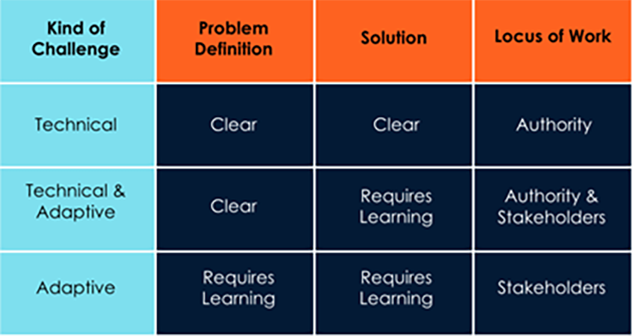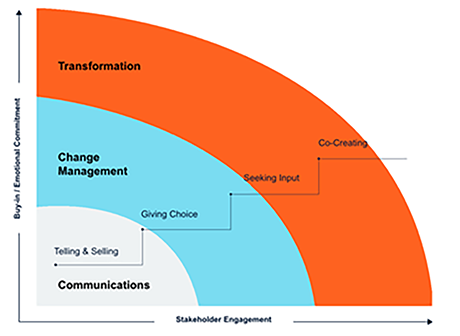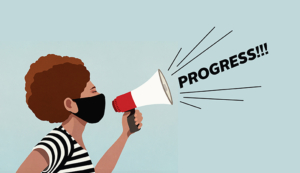To view part one of this two-part series, visit here
Written by
Richard Crespin, CEO, CollaborateUp
Ricardo Michel, Managing Director, FHI Partners
Adaptive leadership
“It is not the strongest of the species that survives, nor the most intelligent that survives. It is the one that is most adaptable to change.” – Charles Darwin
While many problems have only one right answer — changing a flat tire or a light bulb, for instance — adaptive challenges have multiple causes with disagreements on what the causes are, multiple possible solutions that must be tested to see if they will work and multiple stakeholders to implement the identified solutions. To further complicate matters, most people fail to diagnose an adaptive problem and continue to insist on single causes and solutions, viewing other people as “wrong” when they propose alternatives.

Adaptive leadership is the best way to manage multisector partnerships that tackle complex challenges. Alexander Grashow, Marty Linksy and Ronald Heifetz outline adaptive leadership as a series of interconnected activities, including diagnosing the system, mobilizing the system, envisioning yourself as a system and deploying yourself. Their concept puts challenges into two categories: technical and adaptive (see Figure 1). Technical challenges are easily defined, have clear solutions and can be addressed by existing structures of authority. In contrast, adaptive challenges mean that defining the problem will require learning, that reaching a solution will require more learning and that the locus of work will fall upon stakeholders across a variety of sectors. Most importantly, adaptive leaders know that a break from existing methods should not breed fear of failure. Looking at entrenched issues in a new light will be uncomfortable, and that discomfort should be embraced during the problem-solving process.
Stakeholder engagement
“If you want to go fast, go alone; if you want to go far, go together.” – African proverb
The greater the level of change you seek, the greater the level of stakeholder engagement required (see Figure 2). Some problems require only limited stakeholder input. Well-known or relatively basic problems may require simply explaining alternatives (telling and selling) or giving people a choice. Really tough problems require greater levels of engagement by seeking input from others with seemingly opposing viewpoints and giving them an active role in co-creating the potential solution.
Although well-intended, many philanthropic efforts have achieved less than optimal results due to the lack of adequate stakeholder engagement. Unfortunately, the vast majority of philanthropy has involved the wealthy deciding what poor people need and then imposing it upon them. Alternatively, we recommend involving the people you intend to help in co-creating the solution — obvious in theory but difficult in practice. Involving the target population must go beyond the traditional development process of ideas, design, implementation and measurement. Multistakeholder initiatives should take on an agile development approach, continuously involving the target population through constant evaluation and subsequent learning and redesigning.

Take the issue of digital redlining. Historical racial discrimination in mortgage lending practices created unequal distribution of wealth in communities across the United States. Meanwhile, telecommunications providers have recently been removing access to fiber-enhanced broadband improvements in neighborhoods with high poverty rates in cities like Cleveland and Dallas. Increasingly, access to broadband is proving to be an essential service, even more critical in this time of coronavirus. Analysis from the Pew Research Center shows that unequal digital access also unfolds along the urban/rural divide in the United States: Rural Americans are 12 percent less likely than Americans overall to have home broadband.
With recent research by the Brookings Institution arguing that broadband is so influential these days that it is now essential infrastructure — increasing access to job search, education, social support and telehealth services — one can see parallels between issues facing community members of varying backgrounds and the need for a collective vision that lifts all boats. Yet, when CollaborateUp recently proposed crafting a political compromise that might result in broadband funding for both urban and rural communities, we saw pushback by some who said this was the equivalent of saying “All Lives Matter” and that any solution must only focus on communities of color. We would offer that those making the argument for one side over the other should place the problem at the center of the discussion (lack of internet access in poor communities) and be open to compromise to achieve a solution.
Tough conversations
“Sometimes the most important conversations are the most difficult to engage in.” – Jeanne Phillips
In many respects, we have lost the art of conversation. In a world of tweets, posts and video snippets, we only have time or space for staking out positions, not for listening or engaging in dialogue. We need a return to the basics. While dialectical thinking and analysis have fallen out of favor, it is worth reviving and applying it anew. The basic dialectic is of thesis, antithesis and synthesis, in which one set of ideas (the thesis) is confronted by a different or opposing set of ideas (the antithesis) in order to find a common ground and approach (the synthesis). The goal is to have a tough conversation — not to establish who is right or wrong, but to find a solution that the largest number of people can not only live with, but also thrive under.
Through experience, we have developed a formula for having these kinds of tough conversations, built on the Kubler-Ross Transition Curve. Originally created to help people navigate grief, the transition curve can help people come to terms with difficult issues by first recognizing that they are facing a difficult issue. This often involves processing through initial shock and denial, as when people came face-to-face with the social injustice that has been here all along. Many people respond first with shock or denial that these problems even exist, which can quickly turn to frustration, often manifesting as protest or counter-protest. When those actions fail, people may become apathetic or depressed.
As community leaders, we need to help people navigate these stages and then arrive at a point where they are prepared to experiment with new approaches and integrate competing ideas — reframing problems with and instead of or. This requires an extremely collaborative approach and a leadership style that employs active listening to identify concerns and analyze input. It also requires seeing the common humanity in the other and believing that we all share a desire to build a better future. Going down this untraveled road will always be uncomfortable, but it is a fundamental step in reaching a collective solution — especially on issues that require informal interpersonal trust or formal political compromise.
Case study: Digital redlining
Consider again the issue of digital redlining. If we look at that as a right versus right problem, we see that there are two dilemmas: good of the one versus good of the many (“I should get broadband because I paid a premium for my house and can afford it” versus “disadvantaged residents in the community should get broadband at a reduced rate”) and justice versus mercy (“I complied with laws when purchasing my broadband, so why should I pay more than required by law” versus “we should help those who have faced historical discrimination and change the laws to increase their ability to pay for and receive broadband”). When we apply adaptive leadership and problem-first thinking, we place the problem (lack of digital access) at the center and then engage in political and budgetary debate (using the dialectic) to achieve a synthesized legislative and budget compromise that would address the maximum number of digital redlined communities in a given jurisdiction. To effectively engage in that debate, however, we first need to do two things:
- Believe in the other. As many of the parties as possible — starting with you as the leader — need to come to a belief that the other parties want a better future. We specifically say a belief because if we require the other side to prove to us that they share a common desire for a better future, we will never get off the ground.
- Accept trade-offs and buyouts. Compromise is often necessary. For instance, legislative leaders have used earmarks for decades to garner the necessary votes to pass often-controversial legislation, such as the Civil Rights Act or the Clean Air Act. As an adaptive leader, one needs to balance trade-offs of less important objectives with achieving the optimal goal and learn to compromise without compromising the outcome.
Meeting the moment: What can be done?
“Not everything that is faced can be changed, but nothing can be changed until it is faced.” – James Baldwin
Complex issues — systemic racism, the urban/rural divide, unequal economic growth — have deep history and will take many years to resolve fully. Solving these complex problems requires new ways of thinking about ideas that have challenged us for generations. As history has taught us, many seminal efforts have started out in grassroots organizing and protesting. We must continue to face these tough issues in order to bring about change. But, true sustained progress will come about through employing a disciplined approach to achieving collective solutions to ensure true systemic change.
Forging political consensus will mean breaking down problems in a way that creates a vision for, not against. We must face each other, for the benefit of each other. In achieving consensus, we must convince everyone that interpersonal trust can be reached by seeing the very human causes of confrontation — that in discussion and consultation with people different from us, we can see each other’s common humanity and our shared desire to build a better future. Going down the untraveled road will always be uncomfortable, but it is a fundamental step in reaching lasting change.
Further information
This two-part series is part of an ongoing partnership between CollaborateUp and FHI Partners. For more on this and other topics, please contact us at info@collaborateup.com and FHIPartners@fhi360.org and follow us on Twitter at @CollaborateUP and @FHIPartners.

